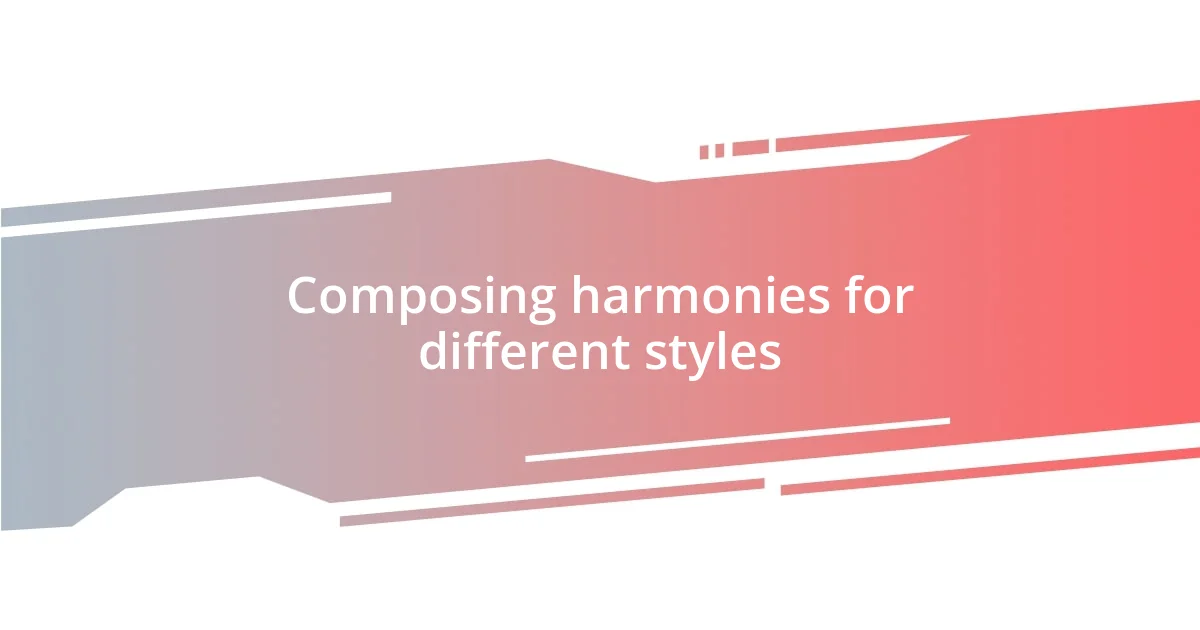Key takeaways:
- Mastering vocal harmonies involves not only hitting the right notes but also active listening and collaboration, enhancing both the music and the bond between musicians.
- Effective techniques for creating harmonies include interval singing, considering vocal ranges, recording practices for feedback, experimenting with chord progressions, and improvisation.
- Recording and performing harmonies require attention to mic placement, mixing patience, effective communication with bandmates, and dynamic control to create an emotional connection with the audience.

Understanding vocal harmonies
Understanding vocal harmonies can feel like deciphering a secret language. I remember the first time I tried to harmonize with a friend; it was thrilling yet nerve-wracking to find the right notes. Each harmony adds a unique emotional layer to the music, transforming a simple melody into something rich and complex.
When I listen to my favorite songs, I often find myself captivated by the interplay between the lead vocals and their harmonies. Have you ever noticed how a well-placed harmony can evoke deeper feelings? It’s fascinating how different combinations can uplift or even create tension within a piece, showcasing the power of vocal blending.
I believe that mastering vocal harmonies isn’t just about hitting the right notes; it’s also about listening and connecting with others. Every time I sing with a group, it feels like we’re weaving a tapestry of sound together, each voice contributing to a shared experience. This connection not only enhances the music but also strengthens our bond as musicians.

Techniques for creating harmonies
Creating harmonies is a blend of intuition and technique. One technique I often use is interval singing, where I focus on specific intervals, like thirds or fifths, above or below the main melody. When I first started experimenting with this, I was surprised by how much character those intervals could add to a song. It felt like discovering a new color in an already vibrant painting.
Here are some effective techniques for crafting harmonies:
- Listen Actively: Pay attention to how harmonies enhance the emotional depth of a song.
- Vocal Ranges: Consider the vocal ranges of all singers involved—keeping them comfortable is key to blending well.
- Record and Review: I frequently record practices; listening back helps identify what works and what doesn’t.
- Experiment with Chords: Play around with different chord progressions; sometimes the simplest change can spark a perfect harmony.
- Improvise Together: Singing in a relaxed environment with friends often leads to spontaneous and beautiful harmonies.
When I harmonize with others, it feels like tuning in to a shared emotion. I recall a memorable session where we just started singing over each other’s lines. The blend created this unexpected magic, and I realized the beauty lies in collaboration—not just technique.

Tools for vocal harmony practice
When it comes to tools for practicing vocal harmonies, there are several invaluable resources that I’ve found helpful over the years. One of my favorites is a digital audio workstation (DAW). It allows me to layer my vocals, tweak pitches, and experiment with harmonies in a user-friendly interface. I vividly remember the first time I recorded myself harmonizing; I was mesmerized by how each layer created a fuller sound. It was like piecing together a musical puzzle that came alive with each note added.
Another fantastic tool is a pitch correction app. I was hesitant at first, thinking it would diminish the authenticity of my voice, but it ended up being a game-changer during practice. This tool helps me fine-tune my harmonies, ensuring I stay in pitch, while still allowing room for my unique sound. Have you ever tried singing along with a pitch app? It can be surprisingly fun and encouraging, pushing you to explore different vocal possibilities without fear.
Lastly, I often use online harmony tutorials or vocal coaching platforms. The structured lessons and expert advice not only teach chords and techniques but also inspire creativity. I remember one session where a video on counterpoint introduced me to an exciting way to create harmonies; it felt like unlocking a secret door to a whole new world of sound. Embracing these tools has significantly broadened my approach to vocal harmonies, making practice both engaging and rewarding.
| Tool | Description |
|---|---|
| Digital Audio Workstation (DAW) | Helps layer and edit vocals for enhanced harmony. |
| Pitch Correction App | Allows for fine-tuning of vocal pitch while practicing. |
| Online Tutorials | Offers structured lessons and inspiration for harmony creation. |

Layering vocal harmonies effectively
Layering vocal harmonies effectively is a nuanced process that requires both listening and experimentation. I remember the first time I was layering harmonies for a song; I experimented with placing a high harmony above the melody and a lower counterpart below. It was like creating a sonic sandwich—each layer added flavor and depth, and I found myself utterly absorbed in the textures they created together.
One key insight I’ve gained is that less can often be more. When I add too many vocal layers, it can muddy the sound rather than enhance it. During a recent session with a friend, we focused on just two harmonies—a third above and a third below the melody. The moment we sang it together, the clarity and warmth resonated in the room. Have you ever noticed how sometimes simplicity brings out the beauty in music? That’s the magic of effective layering—it can elevate a track while keeping its essence intact.
In my experience, vocal dynamics play a crucial role in how harmonies interact. I often adjust the volume and intensity of each layer to create a richer overall effect. A powerful memory for me was when I layered a soft, airy harmony beneath a strong lead vocal; the contrast created an emotional atmosphere that literally sent shivers down my spine. It’s incredible how dynamic layering can transform a piece—have you ever found yourself lost in the sound of perfectly layered voices? That’s the kind of experience that makes all the effort worthwhile.

Composing harmonies for different styles
Composing harmonies varies significantly depending on the genre you’re working with. For instance, when I’m crafting harmonies for a pop song, I often gravitate towards simple, catchy melodies that can stick in someone’s mind. I recall a time when I wrote a harmony for a friend’s upbeat track, focusing on repeating phrases that emulated the infectious quality of the lead. It’s fascinating how a slight change in melody can elevate the overall energy of a song, don’t you think?
In contrast, creating harmonies for a ballad can feel more emotional and intricate. I once took on the challenge of harmonizing a heart-wrenching acoustic piece, where I layered soft, flowing harmonies that complemented the singer’s vulnerability. It was like weaving a delicate fabric of sound, each note adding to the emotion without overshadowing the vocals. Have you ever experienced how certain harmonies can evoke chills? There’s just something powerful about finding the right emotional resonance that can move listeners deeply.
Jazz presents its own unique set of challenges. When I compose harmonies for jazz, I often use extended chords and unconventional intervals. I remember participating in a jam session where I experimented with harmonies that included flat sevenths and ninths—talk about a thrilling moment! The interplay between the lead and harmonies created a rich tapestry of sound that truly brought the performance to life. Isn’t it amazing how exploring different styles can vastly change how you approach harmony? This diversity not only enriches the music but also my personal growth as a vocalist and composer.

Recording vocal harmonies professionally
When I record vocal harmonies professionally, one of my favorite techniques is to establish the foundation with a strong lead vocal. I remember a session where I had a singer lay down the main melody with passion and precision. Then, I carefully crafted harmonies that not only mirrored the lead but also added spice and texture. The result was a captivating blend that filled the studio with energy—did you ever feel how the right lead can set the stage for magic?
Getting the recording environment just right is crucial. I recall a time when I experimented with varying mic placements to capture the nuances of each vocal layer. One technique that worked wonders was placing a condenser mic a few feet away from the vocalist to catch the room’s natural ambiance. The harmonies consequently danced around the lead, creating an immersive listening experience. Have you ever considered how much the right space can transform your recordings? The difference was night and day.
Lastly, I’ve learned that patience is key during the mixing process. After recording, I give each layer its moment to shine—adjusting levels and EQ to ensure clarity. In one memorable project, I spent hours fine-tuning the blend of harmonies until they distinctly complemented each other without overpowering the lead. The moment I hit play and felt the emotions wash over me, I knew we had created something special. Isn’t it rewarding when hard work pays off in sound? Each harmony, when recorded with care, contributes to a richer overall narrative in the music.

Tips for live harmony performance
When I think about performing harmonies live, a crucial aspect is to maintain tight communication with my bandmates. I once performed a song where I turned to my vocalists mid-performance, sharing a nod and a smile that instantly synced our energy. It reminded me that eye contact can make magic happen on stage. Have you ever noticed how those small, non-verbal cues can elevate a performance?
Another tip I swear by is to focus on dynamics. During one unforgettable gig, I experimented with the volume of my harmonies, pulling back during a soft section. The result was breathtaking; when the big chorus hit, the harmonies soared, perfectly complementing the lead. I’ve learned that driving dynamics can take the audience on an emotional journey—don’t you think it’s incredible how sound can make people feel?
Lastly, rehearsal is indispensable. In preparation for a recent performance, we spent hours fine-tuning our blend and practicing transitions. I vividly remember how, after a challenging rehearsal, everything finally clicked into place right before we stepped on stage. That shared confidence radiated into our performance, proving that when you invest in practice, the audience can truly feel your unity. After all, isn’t that connection what live music is all about?















